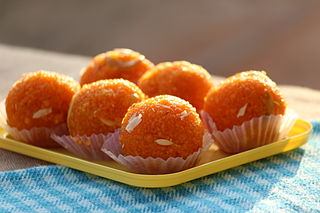
Laddu or laddoo is a spherical sweet from the Indian subcontinent made of various ingredients and sugar syrup or jaggery. It has been described as "perhaps the most universal and ancient of Indian sweets."

Mysore pak is an Indian sweet prepared in ghee. It originated in the city of Mysore, one of the major cities in the Indian state of Karnataka. It is made of generous amounts of ghee, sugar, gram flour, and often cardamom. The texture of this sweet is similar to a buttery and dense cookie. It is also popular in the neighboring countries Pakistan and Bangladesh.

Rajasthani cuisine is the cuisine of the Rajasthan state in North West India. It was influenced by various factors like the warlike lifestyles of its inhabitants, the availability of ingredients in an arid region and by Hindu temple traditions of sampradayas like Pushtimarg and Ramanandi. Food that could last for several days and could be eaten without heating was preferred. Scarcity of water and fresh green vegetables have all had their effect on the cooking. Signature Rajasthani dishes include Dal Baati Churma, Panchratna Dal, Papad ro Saag, Ker Sangri, Gatte ro Saag. It is also known for its snacks like Bikaneri bhujia, Mirchi bada and Kanda kachauri. Other famous dishes include Dal Baati, malaidar special lassi (lassi) and Lashun ki chutney, Mawa lassi from Jodhpur, Alwar ka mawa, Malpauas from Pushkar and rasgulla from Bikaner, "paniya"and "gheriya" from Mewar. Originating for the Marwar region of the state is the concept Marwari Bhojnalaya, or vegetarian restaurants, today found in many parts of India, which offer vegetarian food of the Marwari people. The history also has its effect on the diet as the Rajputs preferred majorly a non-vegetarian diet while the Brahmins, Jains, Bishnois and others preferred a vegetarian diet. So, the state has a myriad of both types of delicacies.

South Asian cuisine, includes the traditional cuisines from the modern-day South Asian republics of Bangladesh, India, Maldives, Nepal, Pakistan and Sri Lanka, also sometimes including the kingdom of Bhutan and the emirate of Afghanistan. Also sometimes known as Desi cuisine, it has been influenced by and also has influenced other Asian cuisines beyond the Indian subcontinent.
Mithai (sweets) are the confectionery and desserts of the Indian subcontinent. Thousands of dedicated shops in India, Bangladesh, Nepal, Pakistan and Sri Lanka sell nothing but sweets.
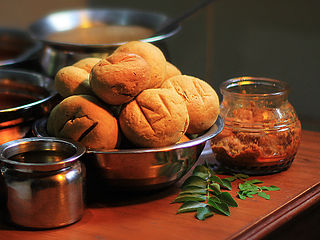
Baati is a hard, unleavened bread cooked in most areas of Rajasthan, and in some parts of Madhya Pradesh and Gujarat states of India. It is prized for its long shelf life and high nutritional content, and, in desert areas, for the minimal quantity of water required for its preparation. Baati is commonly eaten with dal, hence also referred to as dal baati. In some regions, especially Madhya Pradesh, it is also paired with a roasted aubergine mash called bharta. Baati is also closely related to Litti (cuisine), popular in eastern Uttar Pradesh (Varanasi) and western Bihar. Litti is eaten with potato, tomato and roasted aubergine.

Gangaur is a Hindu festival celebrated in the Indian states of Rajasthan, Haryana, the regions of Malwa, Nimar regions of Madhya Pradesh and the Braj and Bundelkhand regions of Uttar Pradesh. It is also celebrated in some parts of Gujarat and West Bengal. A variation of same festival known as Chaitra Gauri Vrat is observed on the same day in the states of Maharashtra and northern Karnataka. Another variation called Saubhagya Gauri Vratam is observed in the states of Telangana and Andhra Pradesh.
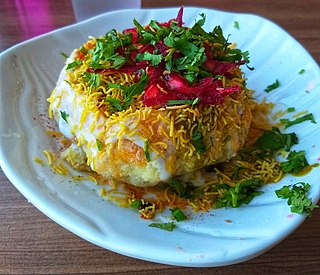
Kachori is a deep-fried, spicy, stuffed pastry originating from the Marwar region of Rajasthan, India. It is made of maida filled with a stuffing of baked mixture of moong dal or onions, besan, coriander, red chili powder, salt and other Indian spices. And deep-fried in oil until crispy golden brown. It is served hot with sweet and spicy tamarind chutney or occasionally with mint and green chilli chutney.

Kadhi or karhi is a yogurt-based dish originating from Rajasthan, india. It's made by simmering yogurt with besan and indian spices until it forms a thick, tangy gravy. Sometimes, it's also mixed with pakoras. It is often eaten with cooked rice or roti.
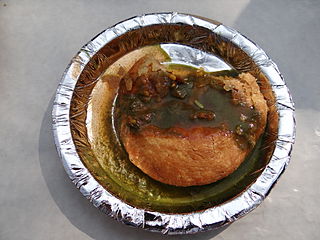
Kanda Kachori or Pyaaz Kachori is a crispy, flaky, deep-fried pastry filled with spiced onion stuffing. It is typically served hot with a sweet and spicy tamarind chutney. Originating in the city of Jodhpur, pyaaz kachori is now enjoyed throughout Rajasthan and North India.

Churma is a popular Rajasthani, Bihari, Uttar Pradesi, Haryanvi, and Awadhi delicacy from India. In Punjab, the dish is called churi. It is coarsely ground wheat, crushed and cooked with ghee and sugar.
Bharunda is a village that comes under Sumerpur Tehsil in Pali district, Rajasthan. The Bharunda is an ancient village well connected to all surrounding villages and towns in the same vicinity.

Panjiri is a Ayurvedic sweet dish from the Indian subcontinent which is specially prepared for Krishna Janmashtami festival. The sweet panjiri evolved from an Ayurvedic preparation called Panchajīraka.

Baigan bharta, also spelled bainganbharta or baigan chokha is an Indian dish prepared by mashing or mincing grilled eggplant (baigan) with tomato, onion, herbs and spices, with variations being common from chef to chef. Traditionally, cooking the eggplants over charcoals, inside of a tandoor, barbecue grill or oven, or even directly applying flame to the outside of the fruit infuses the dish with a smoky flavour; the blackened skin is then easily peeled and the eggplant may be further prepared.
Bihari cuisine is eaten mainly in the eastern Indian state of Bihar, as well as in the places where people originating from the state of Bihar have settled: Jharkhand, Eastern Uttar Pradesh, Bangladesh, Nepal, Mauritius, South Africa, Fiji, some cities of Pakistan, Guyana, Trinidad and Tobago, Suriname, Jamaica, and the Caribbean. Bihari cuisine includes Angika cuisine, Bhojpuri cuisine, Maithil cuisine and Magahi cuisine.
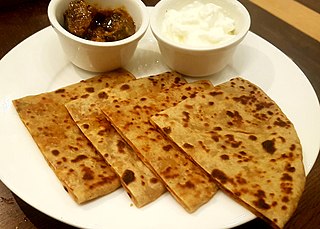
Aloo paratha is a paratha stuffed with potato filling native to the Indian subcontinent. It is traditionally eaten for breakfast.

Aloo mutter is a North Indian dish from the Indian subcontinent which is made from potatoes (Aloo) and peas (mattar) in a mildly spiced creamy tomato based gravy. It is a vegetarian dish. The gravy base is generally cooked with garlic, ginger, onion, tomatoes, cilantro (coriander), cumin seeds, red chilli, turmeric, garam masala, and many other spices. It can also be made without onion or garlic.

Gajar ka halwa, also known as gajorer halua, gajrela, gajar pak, and carrot halwa is a carrot-based sweet dessert pudding made by placing grated carrots in a pot containing a specific amount of water, milk and sugar, cardamom and then cooking while stirring regularly. It is often served with a garnish of almonds and pistachios. The nuts and other items used are first sautéed in ghee, a type of clarified butter from the Indian subcontinent.

Suji ka Halwa is a type of halvah made by toasting semolina in a fat like ghee or oil, and adding a sweetener like sugar syrup or honey or even jaggery powder. It can be served for breakfast or as a dessert item. The basic recipe is made with just semolina, sugar or honey, ghee, and sometimes milk. Variations on this include dried or fresh fruits, nuts, shredded coconut, and other toppings.

Mohanthal is a traditional besan based Indian sweet which is regarded as favourite of Hindu God Bhagwan Krishna and hence prepared on Sri Krishna Janamashtami festival. The sweet Mohanthal is named after Bhagwan Krishna as Mohan is an epithet for Him. Mohanthal forms an quintessential part of bhog in Pushtimarg temples. It is common in the Braj, Rajasthan and Gujarat regions of India where influence of Pushtimarg tradition is higher.
























